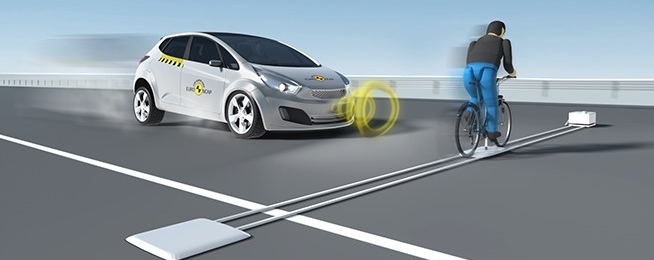For the first time cars have been rated for safety in crashes with bike riders.
The Euro New Car Assessment Program (NCAP) safety rating system now tests not just for the safety of car occupants and pedestrians, but also for the bike riders and pedestrians its shares the streets with.
The first vehicle to get five stars under the new test was the Nissan LEAF, an all electric vehicle.
Australia also has a crash rating body, ANCAP, and even though it has introduced testing for pedestrian safety this year, it does not test for bikes.
Now that it tests for bikes and pedestrians, Euro NCAP refers to its new tests as Vulnerable Road User (VRU) tests.
Cyclist-detection with auto brake technology was tested for the first time on the LEAF.
Detecting cyclists presents new challenges to car manufacturers, both from a hardware and a software perspective: sensors must have a wide angle of view to detect fast-moving cyclists in good time, and complex algorithms are needed to ensure correct identification of potential collision threats while avoiding false activations.
The new protocol was developed by funding from the Dutch government, and involved the participation of European cycling bodies.
Michiel van Ratingen, Secretary General of Euro NCAP, said: “These latest updates in Euro NCAP's active safety testing focus on both the protection of those inside the car and those who share road-space with it.
"Our new assessments demonstrate the increasing level of sophistication that can be achieved by connecting various sensor systems installed on the vehicle. As the cost of these systems drops and computing capabilities increase, standard vehicles will soon become able to help prevent significantly more complex real-life crashes.”
For cyclist detection, Euro NCAP tests two scenarios: one in which the cyclist is crossing the vehicle’s path and one in which the cyclist is travelling in the same direction as the car (two different tests are done for this scenario).
Both scenarios represent typical situations in which potentially fatal accidents occur between cars and cyclists.
A specially designed cyclist target is used for the tests. A bicycle mounted on a moving platform and the dummy cyclist is articulated to recreate the pedalling action of a human.
Detecting cyclists is technically challenging compared to pedestrians as their speeds are higher: Vehicle manufacturers must use sensors with wider fields of view and there is less processing time in which to make a decision to brake or not.
Euro NCAP gives greatest reward where a collision is completely avoided.
In some cases, however, the Automatic Emergency Braking (AEB) system will be unable to stop the vehicle completely and some points are given because any reduction in the speed of impact can have a significant benefit for injury outcome.


